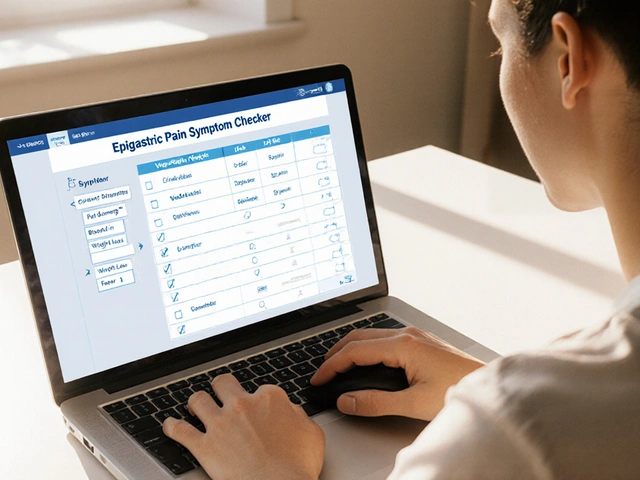Most people hear the word Cytotec and think, 'Isn't that the abortion pill everyone's talking about?' The truth is, that's only part of the story. Cytotec—also known by its generic name, misoprostol—has a wild history and a complicated reputation. Whether you're curious about how it works, considering its uses, or just trying to sift fact from fiction, there’s more to Cytotec than what whispers on the internet make it seem. Dive in for real talk, accurate tips, and things your doctor probably wishes you knew before Googling everything at 2 a.m.
What Is Cytotec and Why Was It Created?
Cytotec didn’t start out as the headline-making drug it is today. Back in the late 1980s, the FDA gave Cytotec the green light for treating stomach ulcers. Surprised? It was designed to protect the stomach lining from damage caused by NSAIDs – meds like ibuprofen or aspirin. Misoprostol works by copying a natural substance in the body called prostaglandin E1. Prostaglandins help keep our stomach protected from rough patches—literally, because they increase mucus and reduce stomach acid. This action makes ulcers less likely and keeps stomach issues at bay.
But if you think its story stops at stomach problems, buckle up. Doctors soon noticed that misoprostol caused the uterus to contract. In the medical world, that was a huge deal. It meant Cytotec became useful for helping women who need their uterus to contract—like after childbirth to prevent heavy bleeding. And yes, it also opened the door for its use in abortions and miscarriage management. But more on that in a minute.
Today, Cytotec is not some fringe medicine. It’s on the World Health Organization’s list of essential drugs. That's like the Hall of Fame for medicine, reserved for treatments so helpful the world can’t do without them. Despite this, Cytotec’s reputation is tangled up in politics, controversy, and a lot of internet myths. The history is messy, but the facts? Clean and straightforward.
How Is Cytotec Used in Women's Health?
Cytotec sits at the center of some pretty big milestones in women’s health. Doctors use it to manage miscarriages, induce labor that isn’t progressing, and even prevent excessive bleeding after delivery—a leading cause of maternal deaths worldwide. In many places, especially countries with limited access to healthcare, Cytotec has literally saved lives by stopping postpartum hemorrhage. That’s not something you hear on social media comment threads, but it’s a big deal.
Now, about abortion—which is where most people have heard of Cytotec. It’s not the only medication used for this, but it’s the backbone of the so-called “abortion pill.” Usually, doctors prescribe another drug first (mifepristone) to block pregnancy hormones. Cytotec comes in after to cause uterine contractions, making the process complete. In some parts of the world, Cytotec alone is used, especially when other drugs are hard to get. But the safety and effectiveness are better with both, according to clinical studies from the past decade.
So how is it taken? Pills can be swallowed, dissolved under the tongue, or even inserted vaginally. Health care providers decide based on each person's situation—no 'one size fits all' here. There are clear, evidence-based protocols, and following them matters a lot for success and safety.

Safety, Side Effects, and Risks of Cytotec
Anything powerful enough to help can also cause trouble when used the wrong way. Cytotec is no different. Typical side effects sound like a nasty stomach bug: nausea, cramping, and diarrhea. If you have ever had to rush to the bathroom after bad takeout, you’ll know what to expect in mild cases. Fevers and chills are also pretty common, especially after higher doses during abortion or miscarriage care.
But let’s get real about the serious risks. Using too much Cytotec, especially without a medical pro around, can lead to heavy bleeding, severe abdominal pain, or uterine rupture (which is rare but life-threatening). That’s why doctors don’t just hand out a bottle and send you on your way. If you ever hear about people buying Cytotec off shady websites or using it without proper medical help, you’re hearing a recipe for disaster. The World Health Organization and every responsible OB-GYN warn against unsupervised use.
Another tip: It’s not for everyone. Pregnant people with previous C-sections, certain uterus conditions, or allergic reactions to prostaglandins shouldn’t use Cytotec for abortion or labor induction. And if you’re taking it for stomach issues? Same deal—talk to your doctor so there’s no ugly surprise.
Cytotec Myths and Realities
This drug attracts urban legends like honey attracts ants. Here’s a popular one: “Cytotec is dangerous and always causes harmful side effects.” Not true. Like any medication, Cytotec has real risks, but millions have used it safely when properly supervised. Studies from the Guttmacher Institute and WHO back up Cytotec’s value, especially in places where options are limited and healthcare isn’t easy to access.
Another myth: “It can be used as a DIY solution for abortion with no risks.” This couldn’t be further from reality. Self-managing medication without guidance leads to incomplete abortions, infections, and complications. And getting Cytotec from online sources? You never really know what’s in that package. The FDA has busted plenty of fake pills in recent years. Your best bet: get Cytotec from a pharmacy, with a real prescription, after talking it through with a pro.
Then there’s the chatter that Cytotec affects fertility or future pregnancies. There’s no research showing lasting problems for most women who use it safely, under a doctor’s guidance. After things settle down and the uterus is healed, getting pregnant again isn’t usually a problem. But skip medical advice, and you’re rolling the dice.

Tips: What You Should Know Before Using Cytotec
Thinking about Cytotec? Here’s how to keep things smart and safe:
- Cytotec should always be used under the watchful eye of a healthcare provider. No DIY pharmacy shortcuts.
- Be honest with your doctor about your medical history. They need to know about previous uterine surgeries, allergies, and any prescriptions you’re taking.
- Expect side effects like cramping, bleeding, nausea, or diarrhea. Have some painkillers and a heating pad ready at home—it really helps.
- After using Cytotec for an abortion or miscarriage, look for signs of heavy bleeding (soaking two pads in an hour), fever, or severe pain. Those need immediate medical attention.
- Don’t mix Cytotec with other meds unless a doctor tells you it’s okay. Some drug interactions can be nasty.
- If you’re nervous or anxious (totally normal!), bring a friend or loved one along, or plan to have someone you trust look out for you afterwards.
- Ask questions! Don’t leave your healthcare provider’s office until you feel clear about when to take each pill, what to expect, and when to call for help.
- Finally, don’t believe everything you read on Facebook groups or forums. Good info comes from doctors, regulated pharmacies, and health organizations like the WHO or your country’s Ministry of Health.
Thousands of research papers and stacks of firsthand stories prove that Cytotec can be a life-saving medicine, not just a controversial headline. Used right, it gives women more control over their health and well-being. Used wrong? It’s a gamble. Stick with the facts, stay smart, and talk to someone trained in women’s health—your future self will thank you for it.






Comments
Yo, Cytotec is seriously one of those meds that's got a bad rep but isn't all that scary if you know what you're dealing with. It’s mainly used for pregnancy-related stuff and to protect your stomach lining, so it’s actually pretty versatile.
But yeah, there are lots of myths flying around about it being some kind of dangerous pill, which just isn’t true when used properly. Like anything, it can have side effects, but that doesn’t mean you should panic.
Safety first though — you always want to get the right advice from a healthcare provider and not just trust random internet posts. Heard people saying it causes instant harm or major complications, which is straight-up misinformation.
Anyone else here had experiences with Cytotec or stories from friends? Would love to hear how it’s worked out for others in real life.
Keep the convo going, y’all! These topics deserve chill, honest talk, not fear mongering.
Look, I'm tired of all the nonsense about Cytotec. It's a medicine, not a conspiracy to mess with women's bodies. If you come at me with some anti-Cytotec propaganda without facts, don’t expect a polite debate.
Misoprostol is critical in reproductive health, and denying its importance because of myths or fears shows ignorance. Have some respect for science and medical professionals, okay?
And no, using Cytotec properly does not make you a reckless person. Stop stigmatizing this and focus on how it helps save lives and manage health.
The real problem? Lack of education and access, not the medicine itself.
I’m here to set the record straight and challenge outdated views.
While I appreciate strong opinions, I believe it’s vital to approach this topic with nuance and recognize the complexities around Cytotec use. It’s not enough to just silence dissent; we must understand concerns and provide clear, comprehensive information.
Many myths stem from historical abuses and lack of clear communication by authorities. Women deserve transparency and safety assurances above all.
Medical jargon often obscures realities and fuels mistrust — that’s why posts like this one, that promise to explain without confusing terms, are crucial.
Does anyone have insight into how regulatory agencies worldwide manage Cytotec’s safety protocols? Examining that could help us form a more informed viewpoint.
This article is a good step toward educating people without the fear-mongering that often surrounds Cytotec. As someone who works in healthcare, I see how devastating misunderstandings can be.
People need clear and empathetic information because too often, patients come in scared due to the myths they’ve encountered online.
Safety tips are especially important — knowing when and how to use medications like misoprostol can make all the difference in outcomes.
Thanks for breaking it down in a way that’s accessible but respectful of the seriousness involved. Hoping more resources follow this lead.
Interesting post. I’m all about motivating people to get informed facts straight on medical topics, especially in women’s health where misinformation runs wild.
Cytotec has multiple uses, and handling it with care is key. The myths simply distract from its benefits.
In India, access to such drugs is patchy, so education is a vital tool to empower women to know their options and take control of their health.
Sharing clear safety info makes a huge difference. Let’s keep pushing for honest and open discussion everywhere.
Waiting to hear other perspectives on this.
Thanks for putting this together. It’s rare to find balanced info on Cytotec that neither demonizes it nor ignores the risks.
In my community, there’s a lot of confusion about such meds, fuelled by superstition and limited access to healthcare professionals.
I think posts like this are necessary to demystify the drug and reduce stigma.
From what I’ve gathered, side effects can vary, but with guidance, they are manageable. What’s crucial is trusting trained providers rather than relying on hearsay.
Would love to hear more about what myths people have encountered specifically, to tackle them head-on.
Quick question folks — does anyone know why Cytotec is sometimes preferred over other drugs in certain treatments?
I understand it works on the uterus and stomach lining but what makes it the go-to compared to alternatives?
Also, are there guidelines for proper dosing that reduce side effects pretty effectively?
Would appreciate some clear answers because I keep hearing mixed things.
@21 Great points! So, Cytotec (misoprostol) is favored in many treatments because it’s effective, affordable, and easy to administer. For stuff like inducing labor or preventing stomach ulcers from NSAIDs, it’s pretty reliable.
Its action on uterine muscles makes it useful for controlled contractions, which other drugs might not do as efficiently or at a comparable cost.
Dosage guidelines are definitely a must, and healthcare providers tailor them depending on what the drug is being used for. Taking it without guidance? Big no-no. Side effects are dose-related, so sticking to protocols is key.
Hope that clears some things up!
Adding to that — there’s ongoing research comparing Cytotec to other cytoprotective agents, and it tends to come out strong because of its dual action potential.
That said, not everyone tolerates it the same, so monitoring and adjustments are essential. We definitely shouldn’t treat it as a one-size-fits-all remedy.
By the way, regarding myths, one common misconception is that Cytotec can cause irreversible harm to a fetus, which is only true if improperly used.
Using it responsibly under medical supervision minimizes risks significantly.
From a linguistic standpoint, it’s interesting how terms around Cytotec often get twisted into alarmist rhetoric. Like how 'side effects' become 'deadly dangers' in some discussions without context.
The jargon-heavy medical descriptions can be confusing but clarity is key to avoid fear. This post helps by simplifying the concepts.
That said, always look at peer-reviewed sources to verify claims. Anecdotal stories online tend to skew perceptions unfairly.
Honestly, I find the aggressive pushback against Cytotec often ignores the very real benefits it brings in reproductive health.
This medication has literally saved lives by preventing excessive bleeding and facilitating needed care.
We should stop demonizing it and start demanding better access and education so no one suffers because of misinformation or stigma.
Anyone who’s used Cytotec appropriately should feel empowered, not scared.
As someone who has studied drug histories, I find the stigma around Cytotec fascinating and a bit tragic. The elitism in dismissing this medicine overlooks its global impact, especially in less developed countries.
Accessible and cost-effective, this drug plays a crucial role but remains misunderstood due to cultural biases and misinformation campaigns.
This post is a necessary rebuttal to ignorance — but more education needs to be disseminated at the grassroots.
Data shows misoprostol’s safety profile is strong when used correctly, which many skeptics fail to acknowledge.
Agree, the cultural aspect here is critical. Women’s health often gets sidelined or politicized, which clouds public perception.
This raises the question about improving healthcare narratives to empower users with knowledge rather than fear and shame.
I’d like to see future coverage include patient stories and expert interviews to humanize the data and bust myths.
Absolutely, real voices add weight to any discussion. In my experience, a lot of healing happens when we provide support alongside info.
Safe use of Cytotec isn't just about the drug, it’s about holistic care including counseling and follow-up.
Hopefully, articles like this one will inspire better approaches on all fronts.